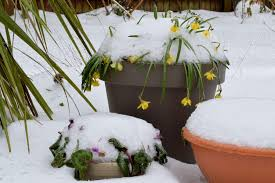As colder weather sets in, protecting your garden from frost becomes a priority. Instead of rushing to buy new materials, consider recycling everyday items you already have around your home. Repurposing is not only eco-friendly but also a cost-effective way to safeguard your plants from frost. Here are some creative ways to use recycled materials to protect your plants during the colder months.
DIY Cold Frames and Cloches
When frost threatens your garden, a homemade cold frame is a great way to keep plants warm. This project is a rite of passage for many gardeners. A cold frame acts as a mini greenhouse, trapping sunlight and warmth to protect your plants.

Materials for Cold Frames:
- Lid/Light: The lid should be made from glass or sturdy plastic to allow sunlight in. Old windows or shower doors are perfect, especially if they already have hinges and handles for easy opening. If you don’t have these features, you can add them yourself with some basic DIY skills.
- Frame: Wood is the best material for building the frame, as it’s easy to work with. Opt for hardwood if available, as it will last longer than softwood. Avoid using treated wood with harmful chemicals, particularly if the frame will sit directly on the soil. If aesthetics are a concern, you can paint the wood with non-toxic paint for a cleaner look.
For those with less time or DIY expertise, recycled plastic boxes, such as old juice bottles, fruit punnets, or clear storage boxes, can be used to create temporary cloches for smaller plants. These items can easily be repurposed to cover and protect seedlings and smaller plants from frost.
Recycled Row Covers
Larger pieces of clear plastic can be used to create a mini hoop house for protecting rows of plants. For example, I once reused thick plastic from a mattress cover to shield tomato plants. I supported the plastic with canes, adding tennis balls to prevent the canes from puncturing the plastic. While not aesthetically perfect, this simple solution worked well to keep the plants safe from frost.
For a more sturdy option, you can use old gas or water pipes as hoops to hold up the plastic. To reinforce the structure, place the hoops over short metal stakes or rigid plastic pipes. This makeshift mini polytunnel will protect rows of plants or dwarf fruit trees from frost. For individual plants, consider using an upturned hanging basket frame covered with clear plastic as a small protective cover.

Using Bubble Wrap for Extra Insulation
Bubble wrap is an excellent way to insulate plants from cold weather. If you have old bubble wrap lying around, it can be repurposed to insulate your greenhouse or hoop house. While horticultural bubble wrap is designed for better insulation, the standard bubble wrap you already have will still work effectively. Simply peg it to the inside of greenhouse panes to create a double-glazing effect that traps warmth and protects plants from frost.
For additional protection, you can loosely wrap individual plants with bubble wrap inside a greenhouse, cold frame, or hoop house. This extra layer of insulation will help safeguard your plants during freezing temperatures.
Protecting Plant Pots from Frost
Potted plants are vulnerable to frost, especially if their roots freeze. Terracotta pots can crack in freezing conditions, but you can prevent this by insulating the pots with recycled materials. Wrap pots in old potato sacks, cardboard, burlap, bubble wrap, or even compost bags. Fill the gap between the pot and the insulation with straw, bracken, or newspaper to provide an extra layer of protection.
Alternatively, place one pot inside a larger pot, then fill the space between the two with straw or compost to insulate the roots.

Final Thoughts
Repurposing everyday items is an easy and effective way to protect your garden from frost. With a little creativity, you can turn old materials into functional garden tools that help your plants survive the winter. Whether you’re using old windows for a cold frame or bubble wrap to insulate your greenhouse, recycling offers practical solutions for keeping your garden safe from the cold.
We hope these ideas inspire you to start reusing and recycling in your garden. What other creative ways have you found to protect your plants? Share your tips in the comments below!
